2001 FORD EXPEDITION tires
[x] Cancel search: tiresPage 223 of 280
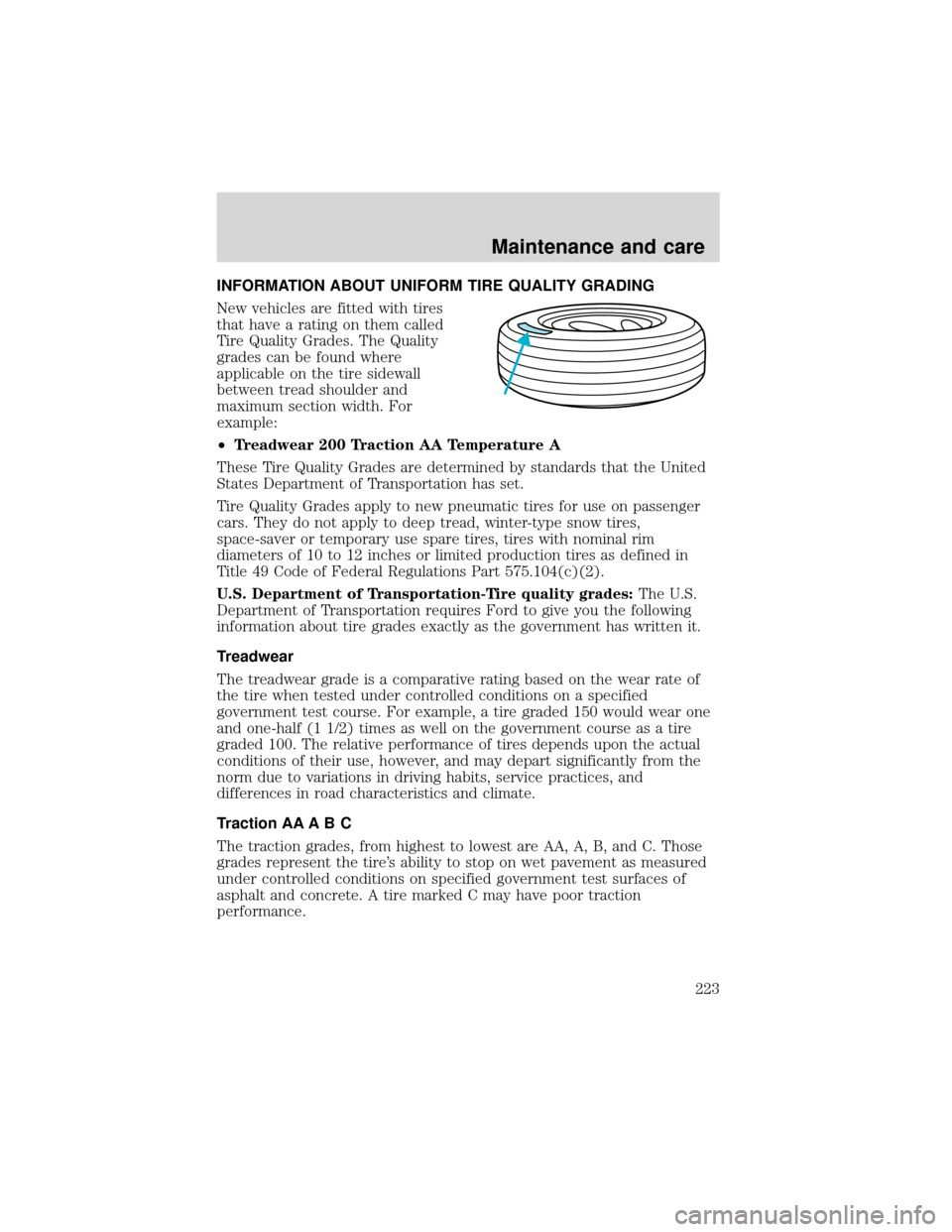
INFORMATION ABOUT UNIFORM TIRE QUALITY GRADING
New vehicles are fitted with tires
that have a rating on them called
Tire Quality Grades. The Quality
grades can be found where
applicable on the tire sidewall
between tread shoulder and
maximum section width. For
example:
•Treadwear 200 Traction AA Temperature A
These Tire Quality Grades are determined by standards that the United
States Department of Transportation has set.
Tire Quality Grades apply to new pneumatic tires for use on passenger
cars. They do not apply to deep tread, winter-type snow tires,
space-saver or temporary use spare tires, tires with nominal rim
diameters of 10 to 12 inches or limited production tires as defined in
Title 49 Code of Federal Regulations Part 575.104(c)(2).
U.S. Department of Transportation-Tire quality grades:The U.S.
Department of Transportation requires Ford to give you the following
information about tire grades exactly as the government has written it.
Treadwear
The treadwear grade is a comparative rating based on the wear rate of
the tire when tested under controlled conditions on a specified
government test course. For example, a tire graded 150 would wear one
and one-half (1 1/2) times as well on the government course as a tire
graded 100. The relative performance of tires depends upon the actual
conditions of their use, however, and may depart significantly from the
norm due to variations in driving habits, service practices, and
differences in road characteristics and climate.
Traction AA A B C
The traction grades, from highest to lowest are AA, A, B, and C. Those
grades represent the tire’s ability to stop on wet pavement as measured
under controlled conditions on specified government test surfaces of
asphalt and concrete. A tire marked C may have poor traction
performance.
Maintenance and care
223
Page 224 of 280

The traction grade assigned to this tire is based on
straight-ahead braking traction tests, and does not include
acceleration, cornering, hydroplaning or peak traction characteristics.
Temperature A B C
The temperature grades are A (the highest), B, and C, representing the
tire’s resistance to the generation of heat and its ability to dissipate heat
when tested under controlled conditions on a specified indoor laboratory
test wheel. Sustained high temperature can cause the material of the tire
to degenerate and reduce tire life, and excessive temperature can lead to
sudden tire failure. The grade C corresponds to a level of performance
which all passenger car tires must meet under the Federal Motor Vehicle
Safety Standard No. 109. Grades B and A represent higher levels of
performance on the laboratory test wheel than the minimum required by
law.
The temperature grade for this tire is established for a tire that
is properly inflated and not overloaded. Excessive speed,
underinflation, or excessive loading, either separately or in
combination, can cause heat buildup and possible tire failure.
SERVICING YOUR TIRES
Checking the tire pressure
•Use an accurate tire pressure gauge.
•Check the tire pressure when tires are cold, after the vehicle has been
parked for at least one hour or has been driven less than 5 km
(3 miles).
•Adjust tire pressure to recommended specifications found on the
Certification Label.
Improperly inflated tires can affect vehicle handling and can fail
suddenly, possibly resulting in loss of vehicle control.
Maintenance and care
224
Page 225 of 280
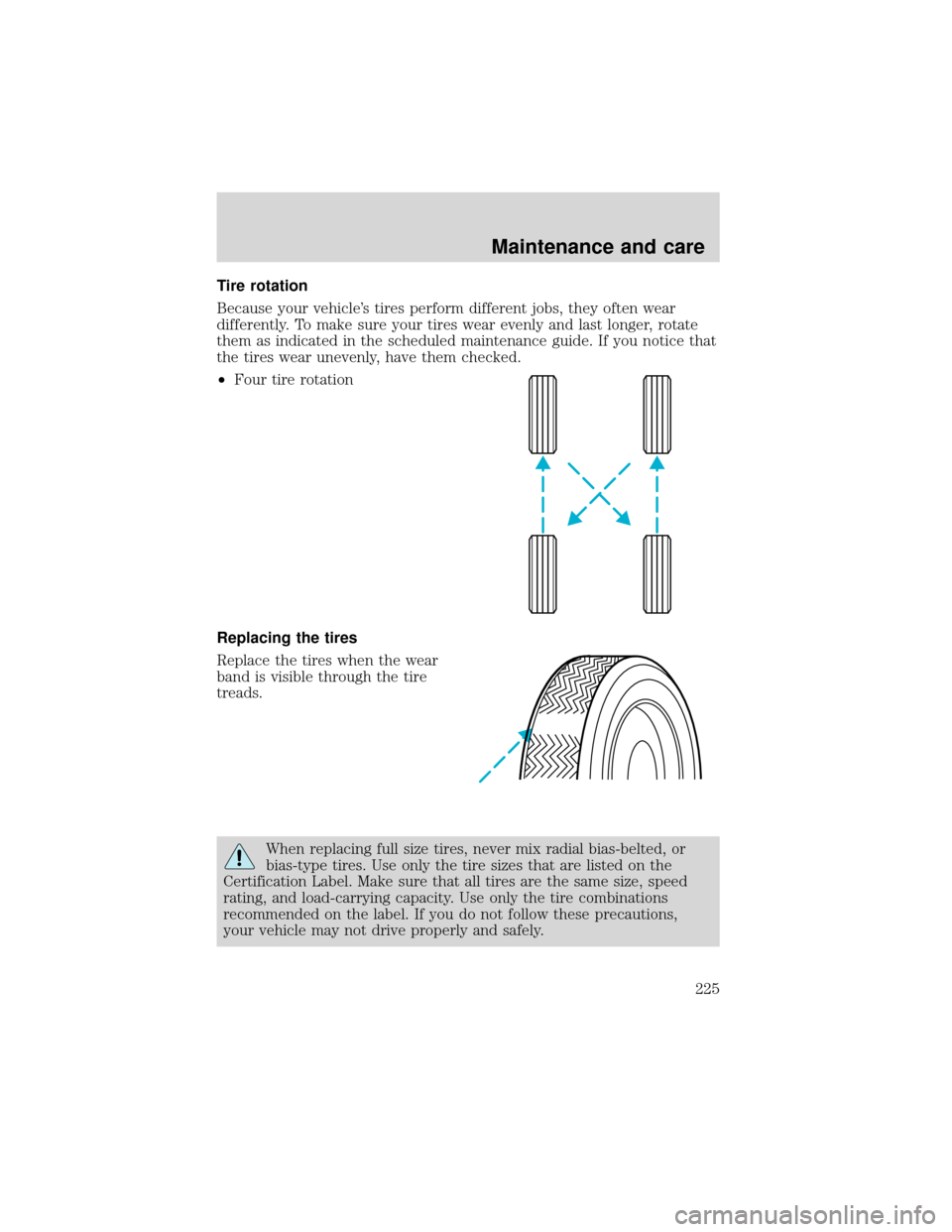
Tire rotation
Because your vehicle’s tires perform different jobs, they often wear
differently. To make sure your tires wear evenly and last longer, rotate
them as indicated in the scheduled maintenance guide. If you notice that
the tires wear unevenly, have them checked.
•Four tire rotation
Replacing the tires
Replace the tires when the wear
band is visible through the tire
treads.
When replacing full size tires, never mix radial bias-belted, or
bias-type tires. Use only the tire sizes that are listed on the
Certification Label. Make sure that all tires are the same size, speed
rating, and load-carrying capacity. Use only the tire combinations
recommended on the label. If you do not follow these precautions,
your vehicle may not drive properly and safely.
Maintenance and care
225
Page 226 of 280

Make sure that all replacement tires are of the same size, type,
load-carrying capacity and tread design (e.g.,“All Terrain”, etc.),
as originally offered by Ford.
Do not replace your tires with“high performance”tires or larger
size tires.
Failure to follow these precautions may adversely affect the
handling of the vehicle and make it easier for the driver to lose
control and roll over.
Tires that are larger or smaller than your vehicle’s original tires may also
affect the accuracy of your speedometer.
SNOW TIRES AND CHAINS
Snow tires must be the same size and grade as the tires you
currently have on your vehicle.
The tires on your vehicle have all weather treads to provide traction in
rain and snow. However, in some climates, you may need to use snow
tires and chains.
Follow these guidelines when using snow tires and chains:
•Use only cable type chains offered by Ford as an accessory or
equivalent. SAE class“S”or other conventional link type chains may
contact and cause damage to the vehicle’s wheel house and/or body.
•Install chains securely, verifying that the chains do not touch any
wiring, brake lines or fuel lines.
•Drive cautiously. If you hear the chains rub or bang against your
vehicle, stop and re-tighten the chains. If this does not work, remove
the chains to prevent damage to your vehicle.
•If possible, avoid fully loading your vehicle.
•Remove the tire chains when they are no longer needed. Do not use
tire chains on dry roads.
•The suspension insulation and bumpers will help prevent vehicle
damage. Do not remove these components from your vehicle when
using snow tires and chains.
•Do not exceed 48 km/h (30 mph) with tire chains on your vehicle.
Maintenance and care
226
Page 234 of 280
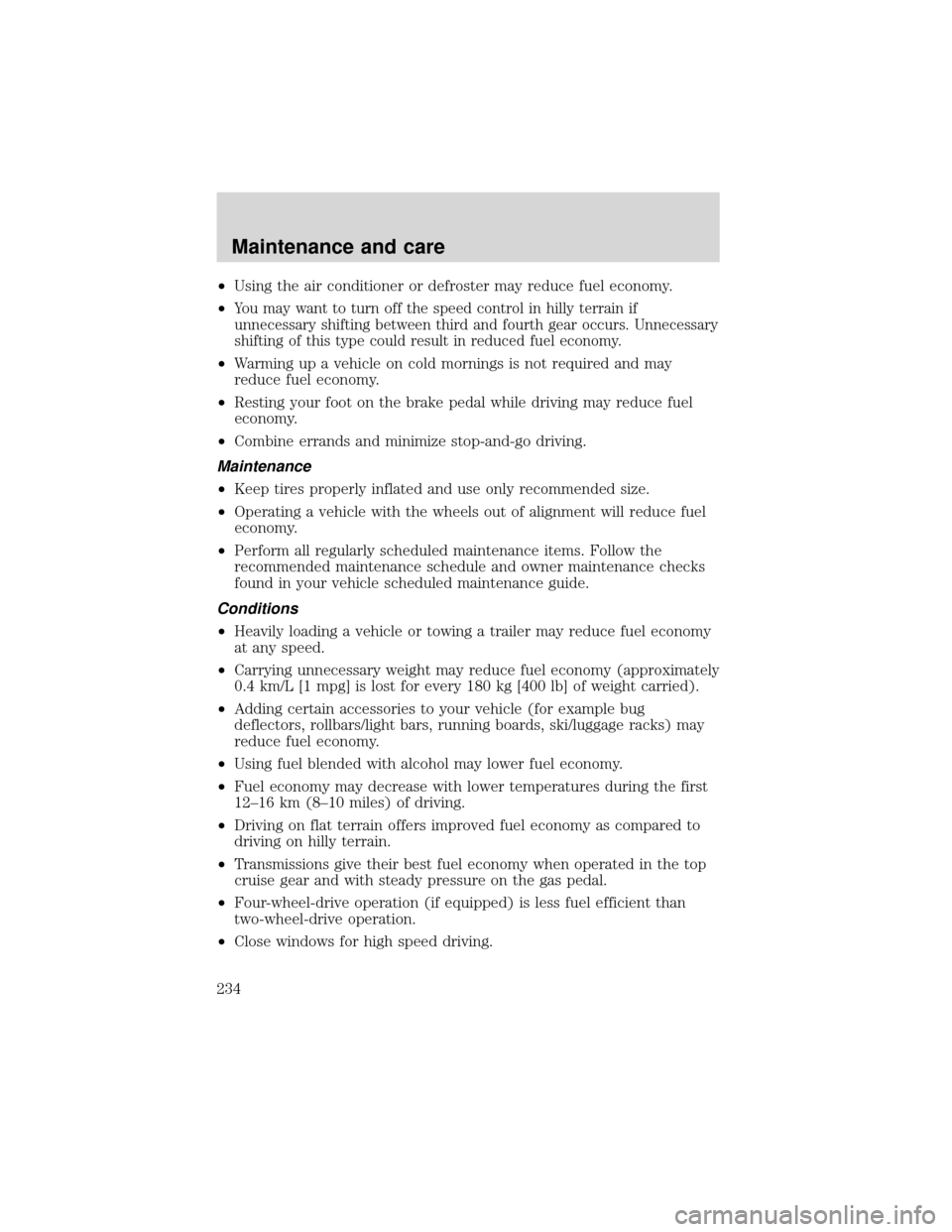
•Using the air conditioner or defroster may reduce fuel economy.
•
You may want to turn off the speed control in hilly terrain if
unnecessary shifting between third and fourth gear occurs. Unnecessary
shifting of this type could result in reduced fuel economy.
•Warming up a vehicle on cold mornings is not required and may
reduce fuel economy.
•Resting your foot on the brake pedal while driving may reduce fuel
economy.
•Combine errands and minimize stop-and-go driving.
Maintenance
•Keep tires properly inflated and use only recommended size.
•Operating a vehicle with the wheels out of alignment will reduce fuel
economy.
•Perform all regularly scheduled maintenance items. Follow the
recommended maintenance schedule and owner maintenance checks
found in your vehicle scheduled maintenance guide.
Conditions
•Heavily loading a vehicle or towing a trailer may reduce fuel economy
at any speed.
•Carrying unnecessary weight may reduce fuel economy (approximately
0.4 km/L [1 mpg] is lost for every 180 kg [400 lb] of weight carried).
•Adding certain accessories to your vehicle (for example bug
deflectors, rollbars/light bars, running boards, ski/luggage racks) may
reduce fuel economy.
•Using fuel blended with alcohol may lower fuel economy.
•Fuel economy may decrease with lower temperatures during the first
12–16 km (8–10 miles) of driving.
•Driving on flat terrain offers improved fuel economy as compared to
driving on hilly terrain.
•Transmissions give their best fuel economy when operated in the top
cruise gear and with steady pressure on the gas pedal.
•Four-wheel-drive operation (if equipped) is less fuel efficient than
two-wheel-drive operation.
•Close windows for high speed driving.
Maintenance and care
234
Page 255 of 280
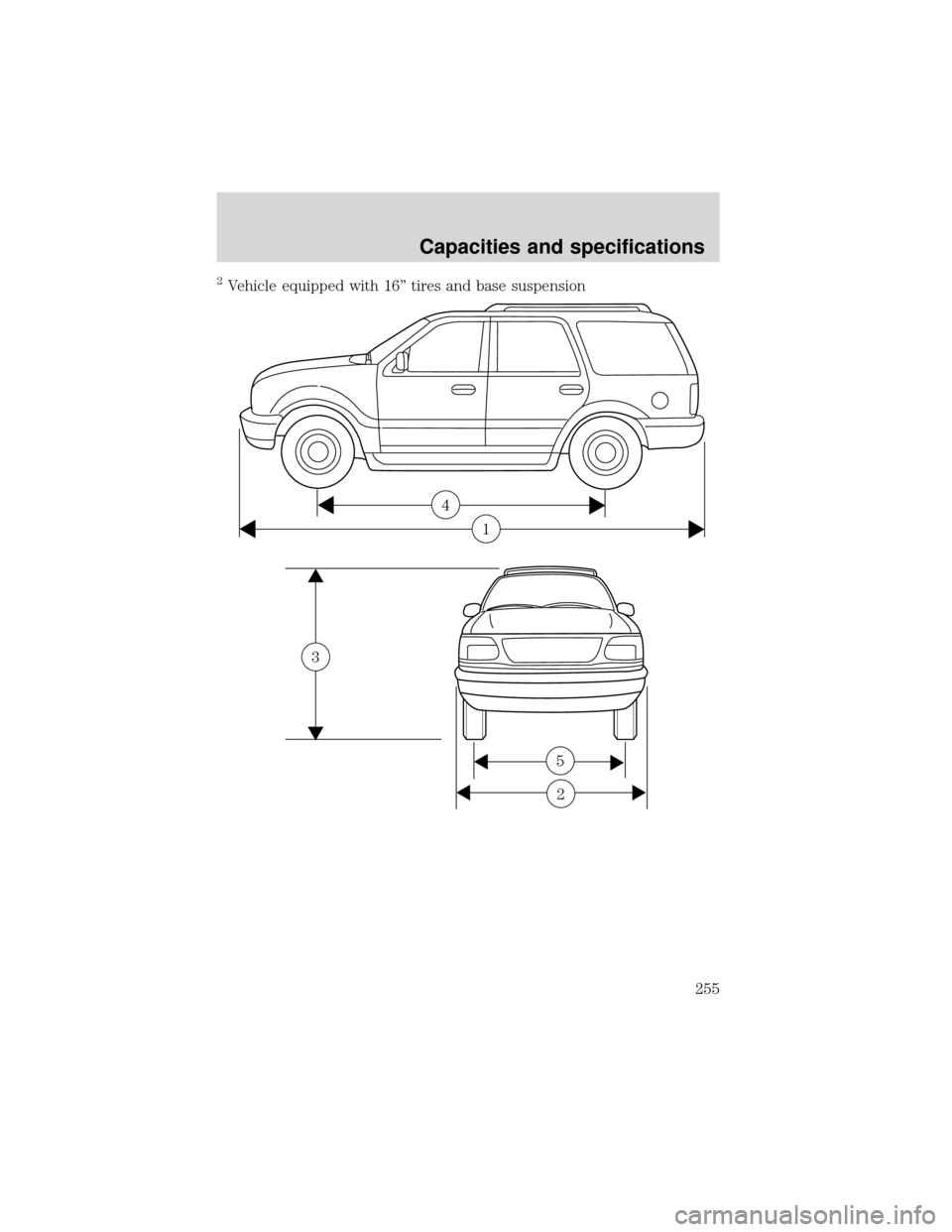
2Vehicle equipped with 16”tires and base suspension
4
1
3
5
2
Capacities and specifications
255
Page 276 of 280
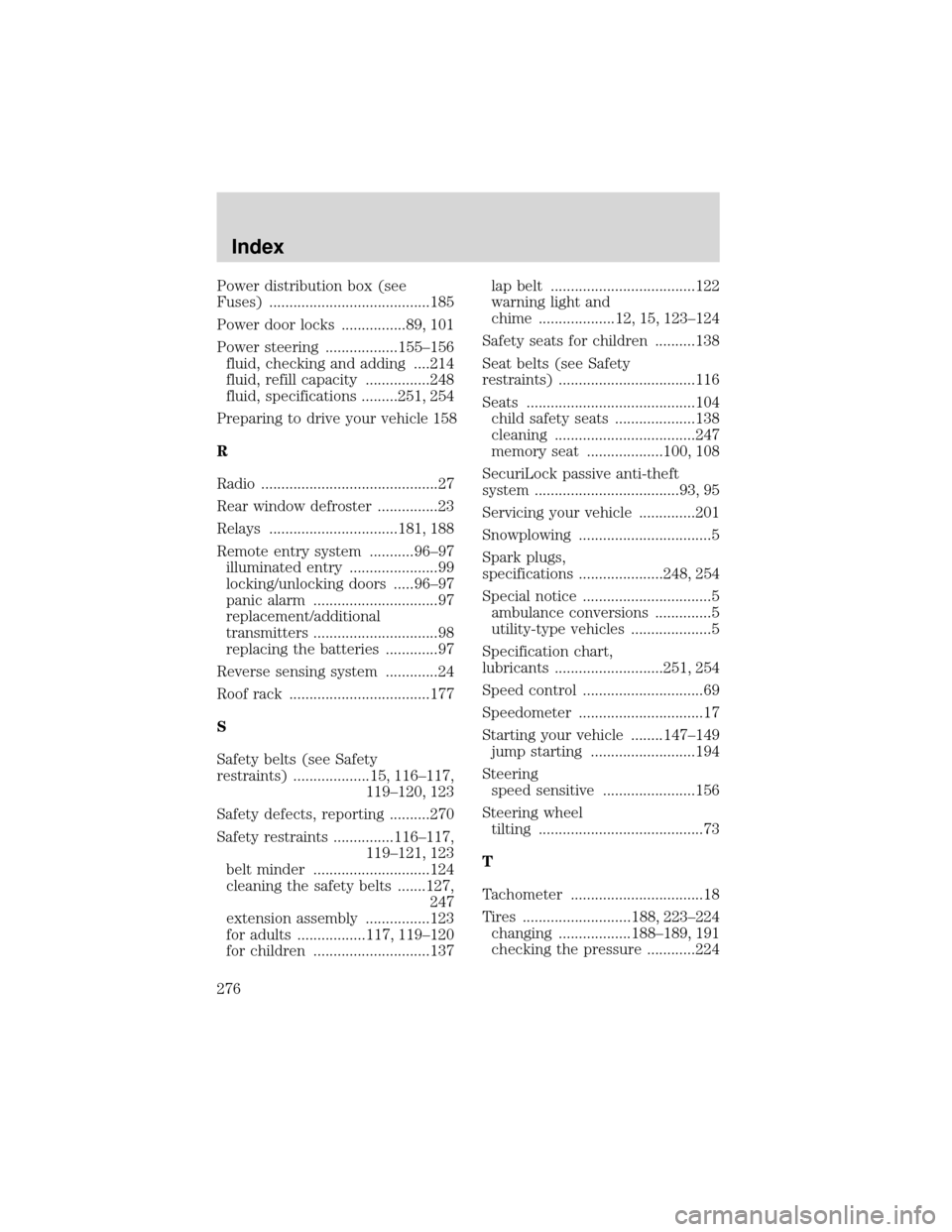
Power distribution box (see
Fuses) ........................................185
Power door locks ................89, 101
Power steering ..................155–156
fluid, checking and adding ....214
fluid, refill capacity ................248
fluid, specifications .........251, 254
Preparing to drive your vehicle 158
R
Radio ............................................27
Rear window defroster ...............23
Relays ................................181, 188
Remote entry system ...........96–97
illuminated entry ......................99
locking/unlocking doors .....96–97
panic alarm ...............................97
replacement/additional
transmitters ...............................98
replacing the batteries .............97
Reverse sensing system .............24
Roof rack ...................................177
S
Safety belts (see Safety
restraints) ...................15, 116–117,
119–120, 123
Safety defects, reporting ..........270
Safety restraints ...............116–117,
119–121, 123
belt minder .............................124
cleaning the safety belts .......127,
247
extension assembly ................123
for adults .................117, 119–120
for children .............................137lap belt ....................................122
warning light and
chime ...................12, 15, 123–124
Safety seats for children ..........138
Seat belts (see Safety
restraints) ..................................116
Seats ..........................................104
child safety seats ....................138
cleaning ...................................247
memory seat ...................100, 108
SecuriLock passive anti-theft
system ....................................93, 95
Servicing your vehicle ..............201
Snowplowing .................................5
Spark plugs,
specifications .....................248, 254
Special notice ................................5
ambulance conversions ..............5
utility-type vehicles ....................5
Specification chart,
lubricants ...........................251, 254
Speed control ..............................69
Speedometer ...............................17
Starting your vehicle ........147–149
jump starting ..........................194
Steering
speed sensitive .......................156
Steering wheel
tilting .........................................73
T
Tachometer .................................18
Tires ...........................188, 223–224
changing ..................188–189, 191
checking the pressure ............224
Index
276
Page 277 of 280

replacing ..................................225
rotating ....................................225
snow tires and chains ............226
tire grades ...............................224
treadwear ................................223
Towing .......................................171
recreational towing .................175
trailer towing ..........................171
wrecker ....................................200
Traction-lok rear axle ...............157
Transmission .............................159
fluid, checking and adding
(automatic) .............................215
fluid, refill capacities ..............248
lubricant
specifications ..................251, 254
Trip odometer .............................18
Turn signal ............................12, 68
V
Vehicle dimensions ...................254
Vehicle Identification Number
(VIN) ..........................................256Vehicle loading ..........................168
Ventilating your vehicle ...........151
W
Warning chimes ...........................15
Warning lights (see Lights) .......10
Washer fluid ..............................207
Water, Driving through .............168
Windows
power .........................................88
rear wiper/washer .....................74
Windshield washer fluid and
wipers
checking and adding fluid .....207
checking and cleaning ............222
liftgate reservoir .....................207
operation ...................................74
replacing wiper blades ...........222
Wrecker towing .........................200
Index
277